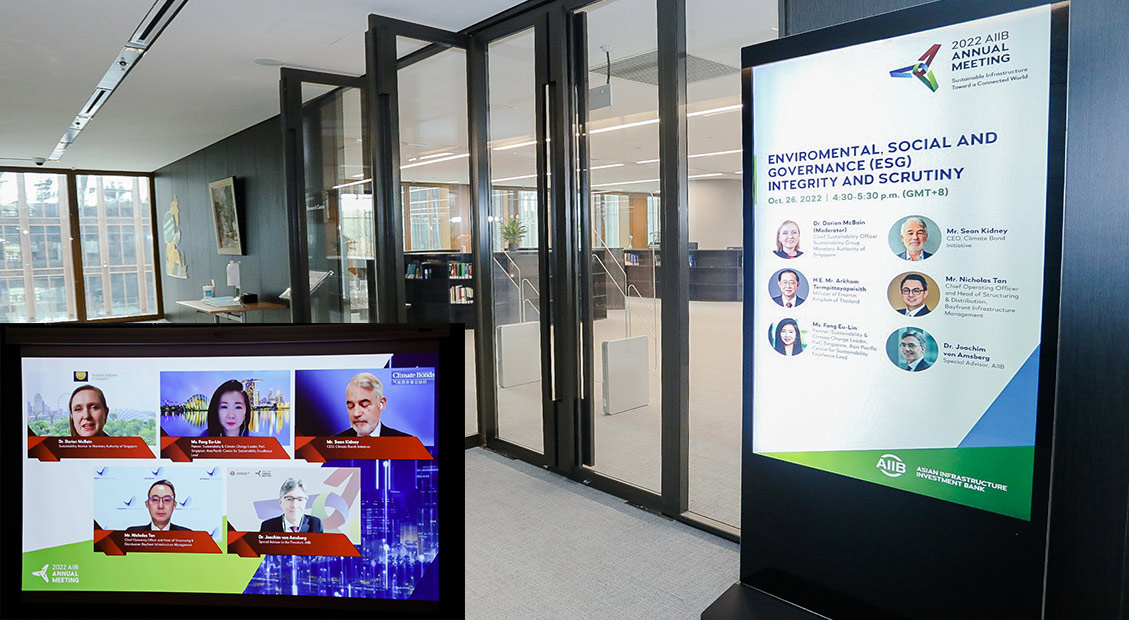Governments, private investors and multilateral development banks (MDB) need to work together closely to ensure that science-based environment, social and governance (ESG) initiatives among countries are implemented properly and at the soonest. This was the call made by expert panelists at the webinar “ESG Integrity and Scrutiny” the 2022 Asian Infrastructure Investment Bank (AIIB) Annual Meeting of the Board of Governors.
Pursuing ESG projects globally, especially those in the emerging and developing world, has been challenging due to the confusion on understanding ESG frameworks and the appropriate direction on their implementation. The webinar aimed to discuss and align expectations on ESG thrusts that involve private and public stakeholders, as well as MDBs.
Even with questions on the finality of ESG standards and frameworks, some governments are not deterred to pursue their ESG initiatives. Thailand, for instance, created the Thailand Sustainability Investment list in 2015, a list of companies that have ESG programs. Thailand’s Minister of Finance Arkhom Termpittayapaisith noted that their government also issued a sustainability bond amounting to THB30 billion (approximately USD805 million), aimed at financing green infrastructure and social impact projects. He also said that the conversation on finalizing the ESG framework must happen with all governments and with MDBs to ensure that the impact of these projects are realized. “In working in sustainability, the public sector can’t go it alone. Rather, it needs cooperation with the private sector and MDBs in moving closer to ESG,” he said.
Because ESG projects are capital intensive, having different interpretations of the standards can result in different methodologies applied by government institutions. Private investors, who rely on existing ESG ratings and taxonomies (classification system for a given list of ESG projects) may also have different expectations as to whether ESG-linked investment funds are worth their money.
New investors could also be hesitant to join. Without critical capital infusion from the private sector, sustainability of some of the existing ESG projects and future projects could be in question.
Panelist Fang Eu-Lin, Sustainability and Climate Change Leader for PricewaterhouseCoopers Singapore, acknowledged that investors and even public organizations are intolerant to poor data quality available on ESG projects.
“I do get that expectations for stakeholders is that they want good standards, which are common baselines,” Fang said.
Still, Fang is hopeful that ESG standards for ESG-linked investments are gradually being improved to ensure that public and private sectors are properly guided.
“While there is demand from stakeholders for better data and standards, parties in the [ESG] ecosystem are trying their best improve the standards alongside auditing standards,” Fang said.
While best practices in ESG standards, ratings and taxonomies are being improved, one of the key concerns is how some institutions, such as government regulators and financial firms, are interpreting the current standards.
Sean Kidney, chief executive officer of the Climate Bond Initiative, gave an example of how some investment firms issued ESG-linked funds that included fossil fuel companies that were identified as “best in class.”
Kidney noted that the science of climate change should be a key point in setting the standards for ESG investments. Scientists need to provide guidance on the effects of climate change that would allow investments to be more acceptable to long-term expectations. “There are absolutes that we have to deal with in terms of how we change. This is not about relative best. It’s about what we should do. At the moment we have a clash of methodologies that we need to work through in terms of our understanding of what ESG means,” Kidney said.
Some investment firms are more rigorously utilizing ESG frameworks and taxonomies. Bayfront Infrastructure Management demonstrated their incorporation of ESG principles. It released its third infrastructure asset-backed securities which includes high-quality green and social assets.
Nicholas Tan, chief operating officer of Bayfront Infrastructure Management, said that their company exercised due diligence on where their assets are invested based on strict application of ESG standards. Individuals and companies that were invested in IABS were given comprehensive information about where their investments would go, as well as the risks involved. As a result, the IABS issuance was oversubscribed, showing that private individuals and institutions are ready to make investments in ESG initiatives.
“Investors will continue to demand more rigor in relation to diligence and demand more of such sustainability-related issuance, so we have to work harder to source for these green and social assets,” Tan said.
Joachim von Amsberg, special advisor to the AIIB President, acknowledged that ESG standards should be scrutinized and agreed upon by stakeholders to minimize the risks for investments. He especially acknowledged the points made by Kidney on having science taking a role in advising all decision makers in ESG standards conversations, as well as Tan whose company demonstrated that investments on ESG projects can be sustainable.
Von Amsberg also said that MDBs can share their years of experience on creating ESG standards and taxonomies to private institutions and governments to move the needle toward commonly accepted standards.
“We can bring private sector experience and MDB experience together and develop an ESG framework that’s suitable for exciting new asset classes that are being created for infrastructure development in developing countries. We’re keen to continue this kind of co-financing and co-investing accompanied by high ESG standards,” Von Amsberg said.
Watch the session replay on AIIB’s YouTube channel


